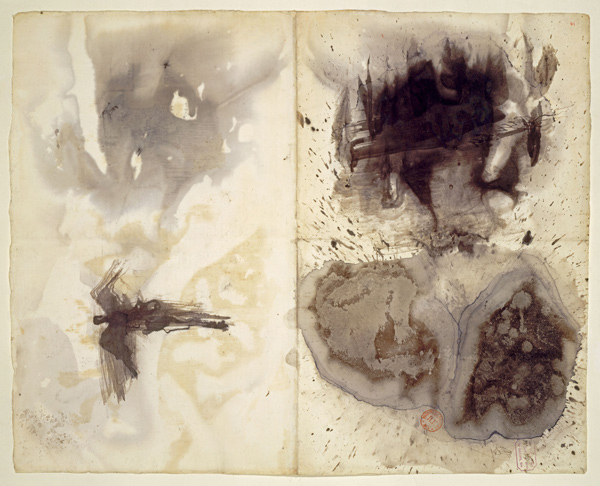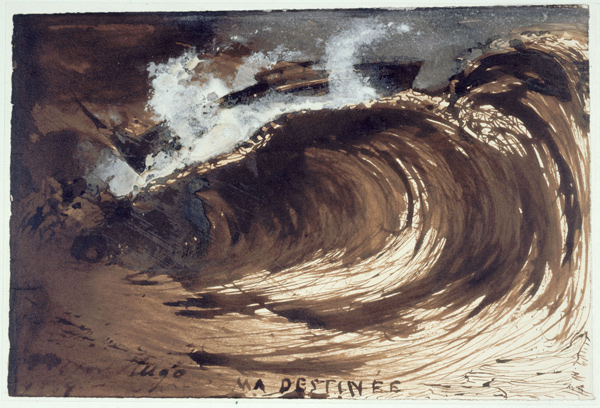When in 1851 the French writer Victor Hugo rose up against the coup d’état initiated by Napoleon III, the police were looking for him. Hugo had to flee Paris, the city in which his first child Leopold passed away in infancy and his beloved nineteen-year old daughter Léopoldine drowned in the Seine. When he departed France, he not only left behind a place subject to political oppression and upheaval, but one in which he also had experienced great personal losses. This is reflected in his literary and visual works.

Victor Hugo, Taches (Stains), ca. 1875(?). Black and gray-blue ink and wash on paper. 17 7/16 × 21 5/8 in. (44.3 × 55 cm). Bibliothèque nationale de France, NAF 24807, fol. 41‒42 © Bibliothèque nationale de France
Hugo made more than 3000 drawings throughout his life. Hammer Museum is currently presenting about 75 of them, which were mainly created during Hugo’s life in exile, when he lived on the English Channel Islands of Jersey and Guernsey. “Stones to Stains: The Drawings of Victor Hugo” presents a rare opportunity as some of the works may not be loaned again due to their fragility. A small collection of stones that Hugo signed and presented to friends and family as mementos as well as photos of the writer are also on display.

Victor Hugo, Souvenir d’un burg des Vosges (Souvenir of a castle in the Vosges), 1857. Brown ink and wash and white gouache on paper. 18 1/2 × 12 3/16 in. (47 × 31 cm). The Metropolitan Museum of Art, New York. Purchase, Harris Brisbane Dick Fund, Donald Young Foundation Gift, Harry G. Sperling Fund, and David M. Tobey Gift, 2012. 2012.17. © The Metropolitan Museum of Art / image source, Art Resource, NY
Among the artworks on view is Ma destinee (1867), a brown ink wash drawing, showing a raging wave and a boat that’s being tossed around, and Etude pour la Tombe de la Leopoldine (1858). Latter is a stencil cut from paper with brown ink, which appears like the mouth of a monster that Hugo used for drawing the tombstones of Léopoldine. Both works seem to be an expression of Hugo’s lingering grief over his drowned daughter.

Victor Hugo, Le phare des Casquets (The Casquets lighthouse), 1866. Brown ink and wash, black crayon, black chalk, and white gouache on paper. 35 3/8 × 18 7/8 in. (89.8 × 48 cm). Maisons de Victor Hugo, Paris / Guernesey, MVHP.D.185 © Maisons de Victor Hugo, Paris / Guernesey / Roger-Viollet
The brown ink drawing Le Phare des Casquets (1866) is a very atmospheric piece reminiscent of the paintings by Caspar David Friedrich and William Turner, created when Hugo started working on his novel L’Homme qui rit (1869), in which a disfigured orphaned boy is left on his own.
-

Victor Hugo, Ecce Lex (Le pendu) (Ecce Lex [hanged man]), 1854. Brown ink, brown and black wash, graphite, charcoal, and white gouache on paper. 20 × 13 3/4 in. (50.8 × 34.9 cm). Maisons de Victor Hugo, Paris / Guernesey. MVHP.D.967 © Maisons de Victor Hugo, Paris / Guernesey / Roger-Viollet
Ecce Lex (1854), a brown ink, graphite and charcoal drawing, depicts the hanging of John Charles Tapner and directly references capital punishment, which Victor Hugo worked throughout his life through his writing and political activism to abolish.
Victor Hugo: “Stones to Stains: The Drawings of Victor Hugo,” September 27 – December 30, 2018, at Hammer Museum, 10899 Wilshire Boulevard, Los Angeles, CA 90024. hammer.ucla.edu



